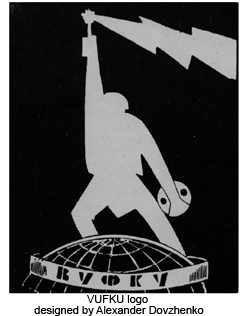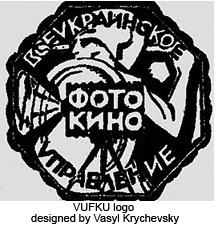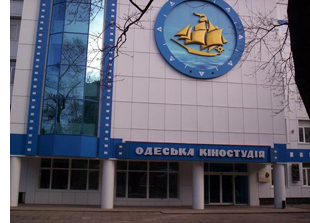History
 This year marks the 90th anniversary of the founding of the Ukrainian film company VUFKU,
which was the longest lived and most productive Soviet film studio of the silent film era.
VUFKU (Vse-Ukrains'ke Foto Kino Upravlinnia, or All-Ukrainian Photo Cinema Administration)
produced a number of silent film masterpieces during the 1920s, including Alexander Dovzhenko's Arsenal and Earth,
and Dziga Vertov's The Man with a Movie Camera.
This year marks the 90th anniversary of the founding of the Ukrainian film company VUFKU,
which was the longest lived and most productive Soviet film studio of the silent film era.
VUFKU (Vse-Ukrains'ke Foto Kino Upravlinnia, or All-Ukrainian Photo Cinema Administration)
produced a number of silent film masterpieces during the 1920s, including Alexander Dovzhenko's Arsenal and Earth,
and Dziga Vertov's The Man with a Movie Camera.
 VUFKU was established on March 13, 1922 under the National Commissar of Education of
the Ukrainian SSR, and was responsible for overseeing all movie theatres, photo companies
and film institutions in Ukraine. At the time of its creation, there were some 20 companies
in post-revolution Ukraine producing films, most of them located in Kyiv, Kharkiv and Odesa.
Although they were small studios, they were able to release some 150 films (mostly shorts)
in 1918 alone. In November 1922, shortly after the creation of VUFKU, Ukrainian authorities
established the state's monopoly over production, distribution, and exhibition of films
in Ukraine, elevating VUFKU's importance. The company became the sole proprietor and
owner of the film industry in Ukraine, as well as the only distributor of foreign films
in the territory of the Ukrainian republic.
VUFKU was established on March 13, 1922 under the National Commissar of Education of
the Ukrainian SSR, and was responsible for overseeing all movie theatres, photo companies
and film institutions in Ukraine. At the time of its creation, there were some 20 companies
in post-revolution Ukraine producing films, most of them located in Kyiv, Kharkiv and Odesa.
Although they were small studios, they were able to release some 150 films (mostly shorts)
in 1918 alone. In November 1922, shortly after the creation of VUFKU, Ukrainian authorities
established the state's monopoly over production, distribution, and exhibition of films
in Ukraine, elevating VUFKU's importance. The company became the sole proprietor and
owner of the film industry in Ukraine, as well as the only distributor of foreign films
in the territory of the Ukrainian republic.
VUFKU acquired a large studio in Odesa, and two small studios (called ateliers) in Kyiv and
Kharkiv. It also leased a studio from the Crimean Commissar of Education in Yalta, as Crimea's
250 days of sunlight were a necessity for an industry that relied on natural light.
VUFKU had ambitious long-term plans and invested accordingly in its infrastructure.
The Odesa studio, which was VUFKU's main production facility, underwent extensive renovations,
purchasing modern equipment in the West, allowing it to shoot and process film stock using
state-of-the-art technology. In 1927, VUFKU began building a new studio in Kyiv, with the
intent of producing nearly 40 feature films per year. The Kyiv studio released its first
films in the 1928-29 budget year, and was at the time one of the most modern film studios
in Europe. During its existence, VUFKU's Odesa studio released 88 feature films, and its
Kyiv studio released 18 features in its first year; in addition, VUFKU released a large number of
documentaries, educational, and agit-prop films.
 Film was considered a commodity and VUFKU was run as an industrial enterprise.
Its management put much emphasis on the efficiency of the production process:
budgets were tightly controlled and new methods were introduced to reduce the production
time and cost of each film. VUFKU tried to emulate the production-line methods of
film-making already in place in the Hollywood studio system. And like major Hollywood
studios of the 1920-30s, VUFKU controlled production, distribution, and exhibition of films.
The company enjoyed exclusive rights for distribution of films on Ukrainian territory, after it
squeezed out independent pre-revolutionary distributors, and did not allow Russian distributors
to enter the market. During the 1920s, any company, including all Soviet ones, had to enter
into an agreement with VUFKU in order to be able to show their films in Ukraine.
Film was considered a commodity and VUFKU was run as an industrial enterprise.
Its management put much emphasis on the efficiency of the production process:
budgets were tightly controlled and new methods were introduced to reduce the production
time and cost of each film. VUFKU tried to emulate the production-line methods of
film-making already in place in the Hollywood studio system. And like major Hollywood
studios of the 1920-30s, VUFKU controlled production, distribution, and exhibition of films.
The company enjoyed exclusive rights for distribution of films on Ukrainian territory, after it
squeezed out independent pre-revolutionary distributors, and did not allow Russian distributors
to enter the market. During the 1920s, any company, including all Soviet ones, had to enter
into an agreement with VUFKU in order to be able to show their films in Ukraine.
The presence of national film studios, such as VUFKU, spurred cultural and business competition
among Soviet studios and contributed to the establishment of a thriving film culture.
It can be argued that Soviet cinema of the 1920s was much more diversified than is
reflected in film histories of that period, and the development of early Soviet cinema
was not propelled so much by post-revolutionary enthusiasm of artistic elites but by
the economic strength of its film industry. The diversity of that industry encompassed
its economic, cultural and organizational aspects and formed along national lines.
The independent business and cultural practices of VUFKU were at the very root of the
company's financial and artistic success. They were also the major points of disagreement
between VUFKU and the Soviet government in Moscow, which began to institute policies
that ensured economic decisions regarding the Ukrainian film industry were no longer
to be made in Ukraine. In February 1929, during a meeting with a delegation of Ukrainian
writers in Moscow, Joseph Stalin outlined his internationalist policy, which had as
its goal the elimination of the multi-national and multi-lingual character of the USSR
and the creation of a new Soviet culture represented by a single language.
 This policy change quickly affected VUFKU and films the company released at the time.
The independent Ukrainian film industry began to lose its autonomy and was eventually
abolished altogether. In 1930, VUFKU was reorganized into Ukrainfilm, a mere branch of
the Soviet Union's centrally managed Soyuzkino film studio.
This policy change quickly affected VUFKU and films the company released at the time.
The independent Ukrainian film industry began to lose its autonomy and was eventually
abolished altogether. In 1930, VUFKU was reorganized into Ukrainfilm, a mere branch of
the Soviet Union's centrally managed Soyuzkino film studio.
The collapse of the Soviet Union in 1991 has brought about new challenges and prospects for filmmaking in the former
Ukrainian SSR, and the legacy of VUFKU in independent Ukraine is continued by the Dovzhenko Film Studio in Kyiv,
and the Odesa Film Studio.